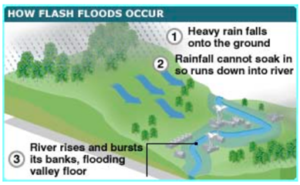Context:
Recently, flash floods and landslides caused by heavy rainfall have resulted in the blocking of the Chandigarh-Manali highway.
About the News:

News Source: The Indian Express
| PYQ: Q. Major cities of India are becoming vulnerable to flood conditions. Discuss. (2016) |
- Flash flood has hit the Bagipul area of Himachal Pradesh’s Mandi district, with over 200 people including tourists and locals stranded.
- Flash floods refers to a flood situation which occurs in a much shorter span of time i.e. six hours.
- In India, flash floods are often associated with cloudbursts – sudden, intense rainfall in a short period of time.
- As per National Disaster Management Authority, nearly 75 percent of the total Indian rainfall is concentrated over a short monsoon season of four months (June to September) which results in rivers witnessing a heavy volume of water.
- As per National Flood Commission, about 40 million hectares of land in India are liable to floods and an average of 18.6 million hectares of land are affected annually.

Image Credits: BBC
Characteristics of Flash Floods:- Occur in Small Catchments: Flash floods occur within small catchments, where the response time of the drainage basin is short.
- Localised: These are highly localised phenomenon.
- High Intensity: Flash floods are characterised by an extremely high volume and intensity of water flow.
- High Velocity: Flash floods are characterised by high speed that increases the destructive potential of flash floods.
- Debris Load: Flash floods often carry a significant amount of debris, including rocks, branches, and mud.
- Unpredictable: At times, Flash floods occur in areas which are not prone to flooding.
- Exceeds Dam Capacity: Flash floods can be caused by factors other than rainfall. For example, when water exceeds the capacity of a dam, it can lead to flash floods.
- Cloud Bursts: In India, flash floods are often associated with cloudbursts, which are sudden, intense rainfall events that occur within a short duration.
- Melting Glaciers: Himalayan states further face the challenge of overflowing glacial lakes, formed due to the melting of glaciers.
- Landslide: Flash floods are accompanied by landslides, which are sudden movements of rock, boulders, earth or debris down a slope.
- Urbanization and Poor Drainage Systems: Urban areas with extensive concrete surfaces and inadequate drainage systems are prone to flash floods. Impervious surfaces prevent water from infiltrating the ground, resulting in rapid runoff and increased flood risk.
- Deforestation and Soil Erosion: Removal of vegetation, such as forests or grasslands, can disrupt the natural water absorption capacity of the soil.
- Loss of life and injuries: Flash floods can pose a serious threat to human life. The sudden and rapid rise of floodwaters can catch people off guard, leading to drowning, injuries, and even fatalities.
- Property damage: Flash floods can cause extensive damage to buildings, infrastructure, and personal property.
- Displacement and homelessness: When flash floods occur, people may be forced to evacuate their homes, leading to temporary or even long-term displacement.
- Environmental impact: They can erode soil, wash away vegetation, and contaminate water sources. The sudden rush of water can disrupt ecosystems, endangering plant and animal life.
- Infrastructure disruption: Flash floods can disrupt critical infrastructure systems such as power supply, water and sanitation facilities, transportation networks, and communication systems.
- IMD’s Flash Flood Guidance Services for South Asia:
- The Flash Flood Guidance is a robust system designed to provide real-time products, supporting the development of warnings for flash floods about 6-12 hours in advance.
- The system operates at the watershed level with a resolution of 4km x 4km, covering flash flood-prone countries in South Asia such as India, Nepal, Bhutan, Bangladesh, and Sri Lanka.
- ISRO’s Landslide Atlas of India: Indian Space Research Organisation (ISRO) has released the Landslide Atlas of India, a detailed guide identifying Landslide Hotspots in the country.
- Early Warning Systems: Implementing robust early warning systems that can detect and predict flash flood events in a timely manner is crucial.
- Improved Infrastructure and Drainage systems: Investing in well-designed and adequately maintained infrastructure, including drainage systems, can help manage and redirect excess water during heavy rainfall events.
- Sustainable Land Management: Encouraging responsible land management practices, such as avoiding excessive excavation and deforestation, can help preserve the natural landscape and prevent soil erosion.
- Afforestation and Soil Conservation: Promoting afforestation and protecting existing forests helps maintain the natural water absorption capacity of the soil.
Additional Information:
About The National Disaster Management Authority (NDMA) guidelines on management of floods:
|
Post Views: 250
